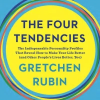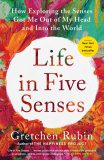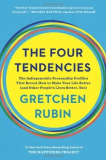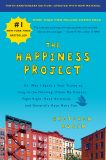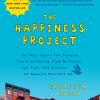

Update:
Looking for the hidden symbol on my redesigned website? Go to gretchenrubin.com, and in my name at the top, look closely at the “t” in “Gretchen.” You’ll see that it looks like the outline of a bird looking up—a nod to the bluebird of happiness I used for the cover of The Happiness Project and elsewhere.
Try this at home
Buy yourself flowers.
I read the observation from Émilie Du Châtelet’s “Discourse on Happiness”: “Let us choose for ourselves our path in life, and let us try to strew that path with flowers.”
Happiness Hack
Use Daylight Savings Time to gain an hour to use in some way. You can use the tools in the Happier app to help keep yourself on track.
Interview
Charlotte Burgess-Auburn is a designer, artist, and educator. She has a new book, You Need a Manifesto: How to Craft Your Convictions and Put Them to Work (Amazon, Bookshop).
We talked about how she became interested in the manifesto form, why its design matters, and why writing a manifesto can help us clarify our values and aims.
Charlotte Burgess-Auburn’s Try This at Home: Make a manifesto.
Demerits & Gold Stars
Elizabeth’s Demerit: She stopped going to yoga.
Gretchen’s Gold Star: I give Elizabeth a gold star to add to the “hit” she gave herself in episode 284 of Happier in Hollywood, about the fact that she’s such a good person to talk to when you need comfort, reassurance, or advice.
Resources
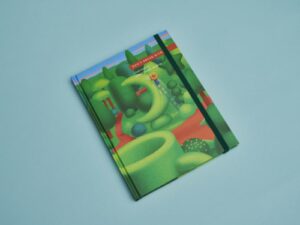

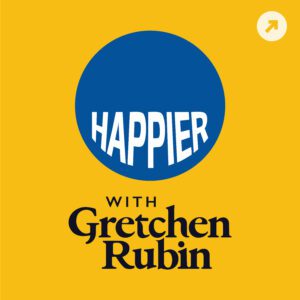

What we’re reading
Gretchen:
Hello and welcome to Happier, a podcast where we talk about strategies and insights for building happier lives. This week we’ll talk about why you might buy yourself flowers and we’ll interview Charlotte Burgess-Auburn about her new book, “You Need a Manifesto.”
[Music]
Gretchen:
I’m Gretchen Rubin, a writer who studies happiness, good habits, the five senses, the Four Tendencies, and all things related to human nature. I’m in my little home office here in New York City, and joining me today from Los Angeles is my sister the sage, Elizabeth Craft.
Elizabeth:
That’s me, Elizabeth Craft, a T.V. writer and producer living in L.A. And Gretchen, I know you love a manifesto, so I’m very excited for this conversation.
Gretchen:
Oh, yeah.
Elizabeth:
I love manifestos, too. So. Okay, everybody, please keep those gift ideas coming! We are doing a gift guide episode in an upcoming episode, so we want your ideas and also your hacks for holiday decorating.
Gretchen:
Yes. And I have heard from people who are looking for the hidden symbol on my redesigned website. Some people have found it; some people have not found it. So if you haven’t found it, go look for it. See if you can spot it. Pause the podcast. Or if you’ve looked in it and you can’t find anything, or you want to know if you’ve found it correctly… if you look at my name in the logo, Gretchen Rubin, Ii you look closely at the tea, you will see that it makes the outline of a bird looking up, and that is a nod to the bluebird of happiness, a very common symbol for happiness, which also appears on the cover of the Happiness Project and sort of appears throughout some of my stuff. So that was just a fun little way to get the bluebird of happiness I alluded to in my name.
Elizabeth:
Love that. Now, Gretchen, in an earlier episode, we talked about running into a listener who told us about eating at our beloved Winstead’s before her wedding reception, after her wedding before her reception. And we had wondered about the logistics of it. So Julia, our listener, sent us a follow-up to answer our question, and she sent photos. She said, “As you can see in the attached photos, the dress remained unscathed by our Winstead’s pre-reception run. My husband reports that we rolled up the windows and covered ourselves in napkins. We went through the drive-thru and my pepper white Mini Cooper. Yes. So love that.
Gretchen:
It was so fun to see the pictures. She’s braver than we are with ketchup and a wedding dress, but she did it, so that was fun to hear. Now, on a more transcendent note, before we jump in here in the United States, remember, the vote in the midterms is coming up on November 8th. All 435 seats in the House of Representatives are up, and 35 of the 100 Senate seats. There are state races all across the country. You may be thinking that you’re going to vote, but research shows that many more people say that they will vote than those who actually do vote. And research also shows that you should make a plan, put it on the calendar, and figure out how you’re going to get there. If you’re going to vote early, when are you going to vote? If you’re going to vote that day, how do you see yourself going to your polling site? And if putting it on the calendar doesn’t work for you, think about your duty to be a role model for other people, or your duty to your future self, or your duty to the country, your identity as a thoughtful citizen, as someone who participates. Elizabeth, I have to say, like, I cannot wait to vote. I’m going to vote early. I have an early polling place at the Met, so it’s perfect for me, I can just go on my daily visit to the Met, and I can vote. I cannot wait. Things feel very chaotic right now, and I feel like this is something that I can do in my own life to uphold the values that are important to me. So I just really want to get this done. So if I fall and break my leg, I know that I have voted, I’ve done it, and I have cast my vote for the representatives who hold my values. How about you?
Elizabeth:
Yeah, same. Gretch, I’m planning to mail my ballot in planning to do it this weekend. And also just want to point out to everyone, if you’re someone who usually only votes in the presidential election, I mean, you know because a lot of people only do that, this is really important. So this is the time to make yourself someone who votes in all elections.
Gretchen:
Yes, every election makes a difference. Every vote makes a difference. So make a plan, however that works for you now.
Elizabeth:
And then you get to wear your sticker.
Gretchen:
Yes! We all want a sticker. I love a sticker. They should make a scratch and sniff sticker. How great would that be? What would be the smell of voting? I don’t know… like fireworks or something. Like a little bit of a firework smell. And Elizabeth, this week, our Try This at Home suggestion is to buy yourself flowers. Now recently, in a More Happier episode, you and I were reminiscing about how we got such a kick out of Flower Fridays, which we had stumbled across when we were doing our live tour. We were in a city on… we think it was Seattle. We’re not sure. I still haven’t heard. We think it was Seattle that had Flower Fridays and we were so enchanted by that idea. And then we got a big response from listeners who also really responded to this idea of Flower Fridays.
Elizabeth:
Yeah, Michelle said, I often buy flowers on Fridays. I will be at home more on the weekend to enjoy them.
Gretchen:
That’s a great point.
Elizabeth:
Which makes sense. Yes.
Gretchen:
Krista uses the strategy of pairing. She said, “Your Friday flowers talk reminded me of my new flower-buying pleasure. I dread going to Costco because it is so busy, and parking is always an issue. I started putting off my Costco list items and avoided shopping there, even though I did want those specific items. I decided to start rewarding my Costco shopping efforts by allowing myself to choose a bouquet of flowers every time I shopped, which is usually once or twice a month. It is an extreme joy to pick a bouquet, which is something I never allowed myself to do. A touch of whimsy. Costco has beautiful and inexpensive bouquets, and this little luxury has me looking forward to an errand I used to dread.” So again, this is a great example of pairing where you pair something that you like to do with something that you really need to do or want to get yourself to do, and in that way, you make the difficult thing a lot easier, and you get flowers.
Elizabeth:
Marjorie said, “I like the idea of Flower Friday, and I might try it out. It reminded me of Sundae Monday. This was a tradition our family started during the summer of the pandemic. We would have ice cream sundaes for dessert every Monday night. We started calling it Sundae Monday. It was a great treat to start the week off right.”
Gretchen:
Well, I love this. It reminds me of Taco Tuesday. And also, Jamie has Ice Cream Saturday. So Jamie is mostly a low-carb eater like me, but he does have a lot of ice cream every Saturday. And we’re always like, “It’s Ice Cream Saturday!” But I love a rhyming one, though. That’s even better.
Elizabeth:
Well, I love, Gretchen, the idea of getting flowers on Friday, in particular, is that it’s that transition to the weekends. Yeah, it’s like putting on your robe.
Gretchen:
Yes, yes.
Elizabeth:
It’s like, okay, these flowers are, like, festive. And now it’s the weekend because I have fresh flowers.
Gretchen:
Well, and as somebody said in your home, it makes sense too, because then your home, you appreciate them. It’s funny; a friend told me that one of the reasons she liked Valentine’s Day was that you would often see people walking around with flowers and balloons or whatever. And it was just like the fun of Halloween, where you just sort of see people on the street celebrating. It’s really fun. Daniella said, “I’ve been a loyal and loving listener for close to five years now and have wanted to write to you many times. When I heard you both discussing Flower Fridays, I knew the time had come to write and share my own experience of Flower Fridays. In recent years, I discovered that having fresh flowers and a vase for the weekend is a real mood and energy booster for me. Flowers just make me smile. So every Friday, I began buying myself flowers or bringing some in from our balcony garden. When COVID came along, and we went into lockdown, I started placing the flowers in the vase on my kitchen floor and snapping a photo. It quickly became an ongoing ritual and project, which I documented on my Instagram with the #flowersandfeetinthekitchen. This past June 1st, I posted the 100th photo and decided the series was complete. My flower photos will soon be exhibited in a lovely little local coffee shop here in Jerusalem. My Flower Fridays brought me joy, calm, and even a feeling of certain stability in these rocky days of COVID.” This is a great thing. You could use the Happier app to do this because you could use the photo log to do that and do it and then keep a lovely record for yourself. So I love that.
Elizabeth:
Beautiful. And then Amanda said, “I live in Estacada, Oregon, just outside of Portland. Although Flower Friday is not a thing here. I’ve made it a thing for me. There are a few local flower farms that offer subscriptions in the summer. For five weeks in July and August, I had a fresh bouquet delivered to my front door. They’re beautiful, local, and sustainably grown. This was the first year I did it and I loved it. I might even do a longer subscription next summer.”
Gretchen:
Well, this is fun. And this reminds me that maybe we’ll mention this in our gift guide also because mom and dad are sort of at the point where they don’t want a bunch of new stuff. It’s kind of hard to think of good gifts for them. I gave them a monthly flower arrangement. There’s a wonderful flower shop in Kansas City, Trapp’s, and so they get an arrangement, and that was our Christmas gift. And mom sends me photos every time it comes so I can see what it’s like. So, yeah, a flower subscription is a great idea.
Elizabeth:
Yeah, and Gretch, we heard from another listener about locally grown Flowers. Magdalene says, “When you talked about implementing Flower Fridays, I immediately thought, ‘they need to know about localflowers.org.’ There is a growing industry of flower farms in the United States, many working small scale with organic and renewable practices that create amazing blooms with incredible vase life because they’re only traveling a short distance to get to you instead of being internationally imported. How do I know about this? Four years ago, we were newly living with my in-laws after we got priced out of a major metropolitan area after the birth of our second child. My mother-in-law and I were both at a personal crossroads, and in one of our long breakfast conversations, I mentioned Gretchen’s idea of looking into one’s 12-year-old self for happiness inspiration. Neither of us knew where that advice would lead us until my father-in-law, on somewhat of a whim, bought an empty half-acre lot in the middle of town. My mother-in-law asked him if she could put in just one row of zinnias. I asked her if I could have just a few of those flowers to play with. Our breakfast conversation started to be about how we each enjoy working with flowers but had always thought of it as something other people got to do. Then the conversation started to take on a more serious tone. More ‘I will if you will.’ One thing led to another, and today we farm a little more than a quarter acre of that formerly empty lot, providing enough flowers from May through October to offer bouquets, subscriptions, weekly farmer’s market posies, and special occasion arrangements to our community. She is the farmer and I’m the florist. It’s working better than I ever thought possible. It is joy in action and I count my lucky stars I get to be a joy-bringer. If you look on localflower.org, you can find us under the Flower Girl TN and as well as local growers near you so you can get some for yourself.”
Gretchen:
Amazing, this is such a happy story. I love this. I love the idea. Like you think, “Oh, that’s what other people get to do. No, I get to do it.” So Christie’s got a good hack about the flowers. Christie says, “My hack for enjoying fresh flowers is to buy an orchid at the grocery store instead of a bouquet of cut flowers. They are beautiful and last about three months. They’re very easy to care for. You can even water them with ice cubes, and after the blooms fade, you can either toss it or, if you’re feeling ambitious, cut off the stock and keep watering it, and it might grow a new stalk and bloom again. Trader Joe’s, Whole Foods, and Costco have reliable, long-lasting orchids for around $20, but lots of chains and local stores have them too. Be sure to buy one with lots of closed buds—it will last even longer, and you’ll get the enjoyment of watching them open.”
Elizabeth:
Well, I do that a lot, Gretch; get an orchid.
Gretchen:
Now and I did something. If you’re looking over, if you’re on YouTube and you’re looking over my shoulder, you can see these red flowers that are always over my shoulder. I copied Mom. Elizabeth, this is our thing in life, just to copy our mother. She bought this beautiful arrangement of paper flowers, and I like them because they invoke flowers, but on the other hand, they don’t try to be convincing. They’re not pretending to be real flowers. They’re just actually paper flowers. And they don’t have that sense of life, but they do have a joyful quality. And so I…
Elizabeth:
Very vivid color.
Gretchen:
Very vivid color. And they kind of invoke flowers. So that’s fun. And this reminds me of one of my favorite quotations from Émilie du Châtelet. “Let us choose for ourselves our path in life, and let us try to strew that path with flowers.”
Elizabeth:
Oh, that’s beautiful.
Gretchen:
Yes. So let us know if you do Try This at Home and how buying flowers for yourself works for you. Let us know on Instagram and Facebook, drop us an email at podcast@gretchenrubin.com, or go to happiercast.com/402 for contact information, info, links, and everything related to this episode.
Elizabeth:
Coming up, we have a Happiness Hack that’s also a Know Yourself Better question. But first, this break.
[Music]
Elizabeth:
It is time for this week’s Happiness Hack.
Gretchen:
Yes, this hack is also a great Know Yourself Better question, which is: If you had an extra hour every day, what would you do with it? And the reason why this is a particularly useful question right now is that in the United States, Daylight Savings Time is coming up on Sunday, November 6th. And you can use that time because if you just keep getting up at the same time your body is used to, it will be an hour earlier by the clock, and so you can get yourself jump-started on getting an earlier wake-up time without actually having to suffer the discomfort of trying to wake up earlier.
Elizabeth:
One thing I love that you point out, Gretchen, is this doesn’t have to be doing something that’s considered “productive.” It could just be doing something you enjoy.
Gretchen:
Right. I mean, you could watch more Real Housewives. I mean, it’s whatever, you know, or like you want to work on a creative project, or you want to do yoga. I mean, yeah, because I think sometimes people are like, “Ooh, I should do meditation or something.” It’s like, yeah; you could watch T.V. or read a novel. I have a friend who reads for fun—he works in publishing, so he has to read all the time for work. And so, for that hour, he just reads purely what he feels like reading. Yeah. And because we’re falling back, you know, spring forward, fall back, we can use that time. And another thing is if you’re thinking about doing this and you want to track it, this is a good thing to use the Happier app because you can use the “One-Sentence Journal,” you can use “Don’t Break the Chain,” you can use a lot of the different tools if you’re trying to use this time to start a new habit. Of course, the Happier app is meant to help you make progress on a habit, so that’s something that you could do for it.
Elizabeth:
Well, Gretch, it’s a good idea. It’s a very good idea.
Gretchen:
Fall back.
Elizabeth:
Now. It’s just a matter of getting up.
Gretchen:
That’s right. That’s right. You have to get up anyway. All right.
Elizabeth:
And now we have a Happiness Interview. Charlotte Burgess-Auburn is a designer, artist, and educator with a background in production for fine arts and theater and experience at the MIT Media Laboratory. She has been the director of community at the Stanford D School since 2005, where she also teaches classes on the role of self-awareness in creativity and design. She has a new book, “You Need a Manifesto: How to Craft Your Convictions and Put Them to Work.”
Gretchen:
Now, of course, as Elizabeth mentioned, I love a manifesto. On my newly redesigned website, on my about page, I have a manifesto. I have a podcast manifesto. I have a habits manifesto. For the Happiness Project, I wrote my 12 Personal Commandments, which is kind of another way of saying manifesto. And for my forthcoming book about the Five Senses, I wrote a manifesto for listening. I love a manifesto. Welcome, Charlotte!
Charlotte
Hi. Thank you so much. I’m so excited to be here.
Gretchen:
Oh, we’re so excited to talk to you.
Elizabeth:
Well, we have to start by just asking, how did you get interested in the manifesto form?
Charlotte
Oh, wow. So I’ve been really interested in that for a long time. Actually, my background is in art and design, and I have been a printmaker pretty much since I was in college. Lots of different forms of print, everything from, you know, potato prints to Xerox machines in terms of technology. And manifestos and, you know, kind of printed pieces have always been really interesting to me from the standpoint of text as graphic, text as art. And that drew me in from the visual side. But as far as the like manifesto as a credo, as a kind of repository for your beliefs and a way to consider how you want to run your life, right, I actually think that that didn’t happen until well after college. And when I was kind of in a period in my life where I had lost several of my family members and was really searching around for stuff that could potentially help me kind of get back on track. And I mean, amazingly, among the many things that I read, The Happiness Project was, in fact, one of the things read.
Gretchen:
Excellent, well, there you go.
Charlotte
And I was like, Wow, this is a really interesting way to go. So it was actually kind of part of my education around, you know, what are the ways that we can all kind of work to keep ourselves grounded and hold ourselves to account over time?
Gretchen:
Well, you mentioned the design. And one of the things that’s very striking about the book is that there’s lots of design. There’s pages that fold out. Like, there’s just a lot going on in every page. How do you think about the role of design in amplifying the credo aspect of the manifesto, or how do you think of that interplay?
Charlotte
Yeah, I mean, I think it’s really key. I don’t know that it’s necessarily key in the book. Like, I love how beautifully designed the book is. And it is critical that we have examples of manifestos in there from Rick Griffith, who is this amazing, amazing designer and manifesto maker. And you know, there is a quote in the book from Marshall McLuhan around the, you know, “the medium is the message,” right?
Charlotte
Design and specifically graphic design in this case, when you think about a manifesto, is part of the delivery mechanism of the message. It changes what the message means, right? That has an effect on that meaning. And so it’s really important to me that people think about that when they think about how they want to create a manifesto or where they want to see their manifesto, how they want to absorb it, how they want to use it. Because the format that it takes makes a huge difference to where it’s going to be used and how it’s going to be used. So everything from, you know, like I have a friend who has a beautiful tattoo on her fingers that says “Make Art” on her finger. So every time she looks at her hands, she sees this message, right? And everything from that to, like, you know, a card that somebody sticks in their wallet. So, yeah.
Elizabeth:
Well, it reminds me we do One-Word Themes every year, and we always say, if you can get a physical manifestation of your theme like mine was Butterfly last year, two people gave me butterfly necklaces, and that just helped me remember. So it’s kind of that same thing where if you can, it’s manifesting the physical way.
Gretchen:
It’s literally the manifesto.
Charlotte
Yeah, exactly. I mean, that is the point of it, right?
Gretchen:
Well, it’s funny because I write these all the time, but I never thought about… I’m such a text person; I never thought about designing it or making it visually interesting beyond just making a bulleted list. So now I’ve got to figure that out. Yeah.
Charlotte
Yeah. I mean, you know, you really do. You have to think about form and think about framework, right? So like, in your case, you’re using a single word, right? And that single word is then carrying actually considerably more meaning than one word generally does carry, right? You’re layering on for yourself meaning, and you’re using that as a shortcut. That one word is a shortcut for you to all the different kinds of things that you want to remember, right? Exactly.
Gretchen:
Holding my salt note card. Yeah.
Charlotte
Right. So those are incredibly effective for lots of people. That kind of method is very, very effective. Other folks have ways that they want to take a look at a kind of larger spread, or they’re really interested in remembering a variety of different facets of a situation or a problem. And one of my favorite manifestos is Sister Corita Kent from the one she did for her students in her art class at Immaculate Heart College.
Gretchen:
That’s a very famous manifesto.
Charlotte
Yeah. And there are ten points in that one. And it’s like the rules of the art, you know, of the art department. And there are different facets, all talking about kind of like, how do you make the making of art less intimidating and more joyful and more productive? But it can’t be encapsulated in a single word, right? You need that kind of larger, longer exploration. And so that’s one of the ones that I use frequently with my students as part of the material to pull apart, to help them pull things apart and put the put back together as their own manifesto.
Elizabeth:
And why do you think they’re so helpful for being able to achieve, like, a happier or more productive life? What is it about the manifesto?
Charlotte
I think it externalizes your beliefs. I think people act according to their beliefs very frequently. Pretty much all the time, right? But it’s hard to say what they are right off the bat, right? And in moments where you get challenged by the decisions that you have to make or the kind of moment you find yourself in, if you don’t have your beliefs outside of yourself and externalized, it’s kind of hard to get in there and make a decision based on them, right? One of the things I talk about in the book is this idea that, like, we are really all being recruited by other people. All the time, right? So our phones are recruiting us 24/7 at this point, and a manifesto is essentially a way for you to recruit yourself into a project of your own, into your own set of beliefs and ways in which you would like to act. And it’s not a map. You know, I say it’s not a map to the future. It is a compass for the present, right? But it does need to be outside of yourself so you can look at it, right? You can experience it. You can look at your Salt word and say, like, “Is the thing that I am doing right now, the decision I’m about to make, does it go with this?” Right? Am I adhering to the things I’ve said I want to do? In that case, it just makes it easier to say, “I’ve already stated that this is something that I want, that this is the way I want to behave. I’m going to hold to that position or I’m going to look at this situation and say something about this situation has changed my mind in particular with relation to this choice. And I can make that choice now.” I can make it intentionally, consciously and say I’m going to make a different decision than maybe I would have made. And that’s going to change my manifesto; it’s going to change what I believe. But I’m able to kind of get it out of this like internal landscape where I’m just kind of like grappling with things and get it out there and make it more direct, more clear, more able to be connected with and crafted and changed when necessary.
Gretchen:
Well, the final thing we always ask our guests is, do you have a Try This at Home suggestion for something that listeners can try themselves tomorrow, something that makes their lives happier, healthier, more productive, and more creative? I think I have an idea of what you might suggest, but what have you got?
Charlotte
Yeah. You need to make a manifesto. And one of the best ways to do that is to go and find, you know, five or six already written manifestos from people whom you admire, from your particular field of work, from, you know, just places where wherever you can find it, whether it’s on the internet or in your stack of books. Find something. Throw it on the Xerox machine. Print it out. Get yourself some scissors and read through. Find things that really resonate with you. Cut them out. Stick them together on a piece of paper and start trying to understand what kinds of patterns you’re seeing, what kind, how that then represents the values that you hold, and how you can, like, begin to create your manifesto on a larger framework. So that very first try is just a very first try, right? It’s always meant to be done again.
Gretchen:
Well, Charlotte, we love manifestos. So has been so fun to talk to you. Congratulations on the book and thank you for talking to us.
Charlotte
Thank you so much, folks. I really appreciate it. Take care.
Elizabeth:
Coming up, I give myself a Happiness Demerit, which is really a Gold Star that has petered out. But first, this break.
[Music]
Gretchen:
Okay, listen, it’s time for Demerits and Gold Stars. And what is this Gold Star that has become faded with time?
Elizabeth:
Oh, my gosh. Scratch. Okay, so recently, I gave Adam a Gold Star for agreeing to go to this Monday night yoga class with me. I’ve been wanting to find a yoga class, the right yoga class, gentle yoga, not some very intense yoga. And after looking around, I found the perfect class every Monday night, and I said to Adam, “We should do this.” And he said, “Yeah, let’s do it.” And he went with me and he was all on board. And I was really happy that we had started going to our Monday yoga class. And I have stopped. That’s the Demerit.
Gretchen:
And why?
Elizabeth:
Well, you know, what happened is I went twice, and then I had to get a procedure done, so I couldn’t go the next Monday. And then, I was in Kansas City the following Monday. And then it’s that thing where once you haven’t gone, it’s really hard to go back even though you want to do it. It’s like you’re mind tells you you don’t want to do it. The first week back, I even justified not going. I said, okay, well, instead I’m going to get my booster shot and my flu shot. So that’s worth not going to yoga for.
Gretchen:
That is important.
Elizabeth:
Of course, I could have done it the next morning, but I… you know what I mean? So it’s like I need to find the will to go and to get back into the routine. It’s the thing. It’s very easy to get out of a good habit.
Gretchen:
Yeah. When it’s funny how starting again is harder than starting.
Elizabeth:
What is that?
Gretchen:
It’s very puzzling, but many people report that going the first time is easier than going back. Well, one thing that you can do, just for what it’s worth, is like if you say, like, I haven’t stopped, I just like I couldn’t go this week, I couldn’t go this week. But like trying to tell yourself I’m still doing it instead of like, I started, I stopped. Now I have to start again and try to reframe it. But yeah, I mean, you may need to get your 21 Strategies for Change checklist out and put it on the calendar, create an accountability partner, pair it with something, buy yourself flowers after yoga. You know, then you don’t have the Flower Friday fun that you said…
Elizabeth:
It will be Monday Flowers.
Gretchen:
Yeah. Flower Yoga. You’re not doing like hot yoga, but you’re doing Flower Yoga…
Elizabeth:
Well, and you say, Gretchen, that often spouses are not good accountability partners because it almost feels like it’s yourself and I guess that seems to be true in this case. But anyway, I will report back to you on the yoga situation. What is your Gold Star?
Gretchen:
Okay. Well, in episode 284 of Happier in Hollywood, of course, which is my other favorite podcast, you talked about how in your Facebook group, you guys have a very active Facebook group which I love to read, how in your Facebook group, people were saying, “Elizabeth’s too hard on herself with giving herself bombs and the Hits and Bomb section.” And so you gave yourself two hits.
Elizabeth:
Yes. That was Sara’s idea. Yes.
Gretchen:
Yes. Well, and you gave yourself a Hit. And I wanted to add my own Gold Star to your Hit, because you said that you thought you were good to talk to, like for somebody who was in trouble or feeling bad about something or needed somebody to bounce something off of, that people seem to find you a sympathetic and helpful interlocutor. And I have to say, as your sister, because you play that role for me all the time, I have to say, I think you really are very gifted in that way. And it does not surprise me at all that people would come to you, whether they need advice or they just need comforting or they need somebody to help them kind of see the funny side. Like, you’re very good to talk to. So I was very happy to see you give yourself that hit. And I wanted to give my own Gold Star just to like double down because it’s a superpower.
Elizabeth:
Well, you know, it’s very important to me. So thank you. I really appreciate that. That makes me feel good.
Gretchen:
Good. Well, there are resources for this week. Okay. These resources are inspired by a direct message that I got. I’m going to keep it anonymous since it was a D.M. So this person wrote, “I started your walking challenge at the beginning of 2020, literally 1/12020, and it was on my 20 for 20 List. I thought the walking challenge would help me make sure I took a break away from my desk each day. I’m an Obliger and ‘Don’t Break the Chain’ works well for me. The walk fairly quickly became a ritual and then an ongoing topic of conversation around the office. One of my friends at work started jokingly saying, Yeah, yeah, 100 or 200 or 300. You get the idea, consecutive days, no big deal. Let me know when you get to day 1,000. And it became a thing. I never missed a day for a full year and partway through my second year my friend asked me when I would hit my 1,000th day, so I decided to figure out the date. I track all my walks and several of us added it to our calendars. 9/26/2022 was that day. I celebrated with a walk/hike of course! I plan to continue on. #OnwardAndUpward #Walk20in20. Thanks again.” So, well done! That’s amazing. I love the fact that everybody in your office was cheering you on and also challenging you. So if you are a fan of the Don’t Break the Chain as discussed, you can get a physical “Don’t Break the Chain Tracker” if you want to track it that way. If you go to happiercast.com/journals—so that’s like a lovely Don’t Break the Chain Journal. Or if you want the convenience of an app, there is a Don’t Break the Chain tool within the Happier app and you can find the app at thehappierapp.com. And so if you also find Don’t Break the Chain a useful approach—some people don’t like it, many people do like it—that’s a physical way and a digital way to keep your chain tracked. And Elizabeth, what are we reading? What are you reading?
Elizabeth:
I am reading “Signal Fires” by Dani Shapiro.
Gretchen:
Well, I read that! I am reading “Life’s Work” by David Milch. And that’s it for this episode of Happier. Remember to Try This at Home: Buy Yourself Flowers. Let us know if you tried it and if it worked for you.
Elizabeth:
Thank you to our guest, Charlotte Burgess-Auburn. You can read her new book, “You Need a Manifesto.” thanks to our executive producer, Chuck Reed, and everyone at Cadence 13. Get in touch. Gretchen’s on Instagram at @gretchenrubin and I’m @lizcraft. Our email address is podcast@gretchenrubin.com.
Gretchen:
And if you have a friend who you think, “Hey, my friend would love to buy herself for himself flowers,” or you think, “Hey, I know someone who needs a manifesto,” please tell your friend about the show. That’s how we find new listeners. You can just text or email them a link to this episode.
Elizabeth:
Until next week, I’m Elizabeth Craft.
Gretchen:
And I’m Gretchen Rubin. Thanks for joining us. Onward and upward.
[Music]
Elizabeth:
I think Charlotte’s the first guest that we’ve had joining us from a car.
Gretchen:
I know. Yes. And it sounded like the sound sounded perfect. Yes. It was funny to see her there.
Elizabeth:
Yeah. And I could see people walking behind her sometimes.
Gretchen:
Yeah. Oh, it’s funny.
[Music]

